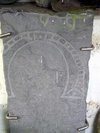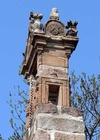| Dunnideer, tower house and vitrified hill fort remains |
|---|

A dramatic hilltop ruin with stunning views over the surrounding countryside. More Information |
| Percylieu Stone |

Pictish class 1 stone with part of a Salmon and Horseshoe symbols. More Information |
| Picardy Stone, Myreton |

Class 1 Grey Whinstone Pictish Symbol Stone, 201cm x 102cm x 60cm. Three carved symbols on the south face, from top: Double Disc and Z-rod; Snake and Z-rod and a mirror. The stone stands on its original site, a low cairn, which is in a fenced enclosure, in front of the stone was a grave, this association makes this stone important to those who support the theory of symbol stones as memorials to dead individuals. More Information |
| Radulfus Slab, St Drostans Church, Insch |

The two medieval burial monuments have been placed against the outer face of the WNW gable. The first, which measures 1.05m in height, is the head and torso of the effigy of a knight dating to the late 13th- or early 14th century. It is heavily weathered, and the figure's face has sheered off, but traces of detail survive along its more sheltered sides; the figure is clad in mail armour, with a coif, a surcoat, a belt, and a large shield. Beside the effigy there is a grave-slab of red sandstone measuring 1.8m in length by 50mm in thickness and tapering in breadth from 0.43m to 0.34m. At its wider end a wedge-armed cross has been incised within a circle. Running along the slab is an incised inscription reading: ORATE:PRO:ANIMA:RADULFI:SACERDOTIS:. |
| Smithy Weathervane Dunnydeer |

A weathervane that combines the traditional cock with an anvil leaving no doubt about the trade conducted in the premises below. More Information |
| St Drostans Church Insch Bellcot |

All that remains of the old kirk of Insch, said to be gifted to the Abbey of Lindores before 1195, is the W. gable complete with a stunning example of a 17th - century pedimented bellcote, in ornately carved red sandstone. The elaborate carving includes the letters M I L , The minister John Logie and the date 1613 |
| The Wolf Stone |

Pictish Class 1 stone bearing the rectangle symbol sometimes described as a book case and a wolf, plus the mirror and comb symbol. More Information |
This content was submitted by external contributors and does not necessarily reflect the views of the University of Aberdeen.
